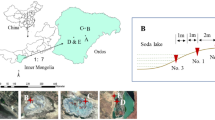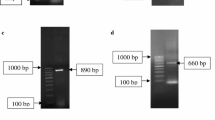Abstract
Reduced sulfur compounds produced by the metabolism are the one of the major problems in aquaculture. In the present study, herbivorous fishes have been cultured as biomanipulators for secretions of slime, which enhanced the production of greenwater containing beneficial bacteria. The genes encoding soxB which is largely unique to sulfur-oxidizing bacteria (SOB) due to its hydrolytic function has been targeted for examining the diversity of SOB in the green water system of coastal aquaculture. Novel sequences obtained based on the sequencing of metagenomic clone libraries for soxB genes revealed the abundance of SOB in green water system. Phylogenetic tree constructed from aligned amino acid sequences demonstrated that different clusters have only 82–93% match with Roseobacter sp., Phaeobacter sp., Roseovarius sp., Sulfitobacter sp., Ruegeria sp., and Oceanibulbus sp. The level of conservation of the soxB amino acid sequences ranged from 42% to 71%. 16S rRNA gene analyses of enrichment culture from green water system revealed the presence of Pseudoxanthomonas sp., which has 97% similarity with nutritionally fastidious Indian strain of Pseudoxanthomonas mexicana—a sulfur chemolithotrophic γ-proteobacterium. Our results illustrate the relevance of SOB in the functioning of the green water system of coastal shrimp aquaculture for oxidation of reduced sulfur compounds, which in turn maintain the sulfide concentration well within the prescribed safe levels.







Similar content being viewed by others
References
Sachidanandamurthy, K. L., & Yajurvedi, H. N. (2006). A study on physicochemical parameters of an aquaculture body in Mysore city, Karnataka. India J Environ Biol, 27(4), 615–618.
Baliao, D. D., De Los Santo, M. A., & Franco, N. M. (1999). Milkfish pond culture. Aquaculture Extension manual no. 25. Ilo-ilo: SEAFDEC.
Baliao, D. D. (2000). Environment-friendly schemes in intensive shrimp farming. State of the art Series. Ilo-ilo: SEAFDEC.
Bagarinao, T. (1998). Historical and current trends in milkfish farming in the Philippines. In S. S. de Silva (Ed.), Tropical mariculture (pp. 381–422). London: Academic.
de la Rosa, J. S. (2004). Greenwater technology: A new shrimp culture technique. BAR Digest, http://www.bar.gov.ph/bardigest/2004/janmar04_greenwater.asp
Yearlsley, G. K. (1999). Australian seafood handbook. Hobart: CSIRO Marine Research.
Tookwinas, S. (2000). Closed-recirculating shrimp farming system. State of the art series. Ilo-ilo: SEAFDEC.
Krishnani, K. K., Shekhar, M. S., Gupta, B. P., & Gopikrishna, G. (2009). Sequence similarity based identification of nitrifying bacteria in coastal aquaculture for bioremediation predictability. Asian Fisheries Science, 22, 41–49.
Krishnani, K. K., Shekhar, M. S., Gopikrishna, G., & Gupta, B. P. (2009). Molecular biological characterization and biostimulation of ammonia oxidizing bacteria in brackishwater aquaculture. Journal of Environmental Science and Health, A-l44(14), 1–11.
Ghosh, W., & Roy, P. (2007). Chemolithotrophic oxidation of thiosulphate and tetrathionate by novel strains of Azospirillum and Pseudoxanthomonas isolated from the rhizosphere of an Indian tropical leguminous plant. Current Science, 93(11), 1613–1615.
Ghosh, W., & Roy, P. (2006). Mesorhizobium thiogangeticum sp. nov., a novel sulfur-oxidizing chemolithoautotroph from rhizosphere soil of an Indian tropical leguminous plant. International Journal of Systematic and Evolutionary Microbiology, 56, 91–97.
Kumar, P. A., Jyothsna, T. S., Srinivas, T. N., Sasikala, C. H., Ramana, C. H. V., & Imhoff, J. F. (2007). Marichromatium bheemlicum sp. nov., a non-diazotrophic, photosynthetic gammaproteobacterium from a marine aquaculture pond. International Journal of Systematic and Evolutionary Microbiology, 57, 1261–1265.
Srinivas, T. N., Kumar, P. A., Sasikala, C. H., & Ramana, C. H. V. (2007). Rhodovulum imhoffii sp. nov. International Journal of Systematic and Evolutionary Microbiology, 57(2), 228–232.
Petri, R., Podgorsek, L., & Imhoff, F. (2001). Phylogeny and distribution of the soxB gene among thiosulfate-oxidizing bacteria. FEMS Microbiology Letters, 197, 171–178.
Meyer, B., Imhoff, J. F., & Kuever, J. (2007). Molecular analysis of the distribution and phylogeny of the soxB gene among sulfur-oxidizing bacteria - evolution of the Sox sulfur oxidation enzyme system. Environmental Microbiology, 9(12), 2957–2977.
Chen, L., Li, W., Liu, S., Tao, M., Long, Y., Duan, W., et al. (2009). Novel genetic markers derived from the DNA fragments of sox genes. Molecular and Cellular Probes, 23, 157–165.
Anandham, R., Indiragandhi, P., Madhaiyan, M., Ryu, K. Y., Jee, H. J., & Sa, T. M. (2008). Chemolithoautotrophic oxidation of thiosulfate and phylogenetic distribution of sulfur oxidation gene (soxB) in rhizobacteria isolated from crop plants. Research in Microbiology, 159, 579–589.
Anandham, R., Indiragandhi, P., Madhaiyan, M., Chung, J., Ryu, K. Y., Jee, H. J., et al. (2009). Thiosulfate oxidation and mixotrophic growth of Methylobacterium goesingense and Methylobacterium fujisawaense. Journal of Microbiology and Biotechnology, 19(1), 17–22.
Sakano, Y., & Kerkhof, L. (1998). Assessment of changes in microbial community structure during operation of an ammonia biofilter with molecular tools. Applied and Environmental Microbiology, 64, 4877–4882.
Kelly, D. P., Shergill, J. K., Lu, W. P., & Wood, W. P. (1997). Oxidative metabolism of inorganic sulfur compounds by bacteria. Antonie Van Leeuwenhoek, 71, 95–107.
Kelly, D. P., & Wood, A. P. (2000). Reclassification of some species of Thiobacillus to the newly designated genera Acidithiobacillus gen. nov., Halothiobacillus gen. nov. and Thermithiobacillus gen. nov. International Journal of Systematic and Evolutionary Microbiology, 50, 511–516.
Ghosh, W., Mallick, S., & Dasgupta, S. K. (2009). Origin of the Sox multienzyme complex system in ancient thermophilic bacteria and coevolution of its constituent proteins. Research in Microbiology, 160(6), 409–420.
Lahiri, C., Mandal, S., Ghosh, W., Dam, B., & Roy, P. (2006). A novel gene cluster soxSRT is essential for the chemolithotrophic oxidation of thiosulfate and tetrathionate by Pseudaminobacter salicylatoxidans KCT001. Current Microbiology, 52(4), 267–273.
Welte, C., Hafner, S., Krätzer, C., Quentmeier, A., Friedrich, C. G., & Dahl, C. (2009). Interaction between Sox proteins of two physiologically distinct bacteria and a new protein involved in thiosulfate oxidation. FEBS Letters, 17(583(8)), 1281–1286.
Wodara, C., Kostka, S., Egert, M., Kelly, D. P., & Friedrich, C. G. (1994). Identification and sequence analysis of the soxB gene essential for sulfur oxidation of Paracoccus denitrificans GB17. Journal of Bacteriology, 176(20), 6188–6191.
Lu, W.-P., & Kelly, D. P. (1983). Purification and some properties of two principal enzymes of the thiosulfate-oxidizing multi-enzyme system from Thiobacillus A2. Journal of General Microbiology, 129, 3549–3564.
Gonzalez, J. M., Kiene, R. P., & Moran, M. A. (1999). Transformation of sulfur compounds by an abundant lineage of marine bacteria in the subclass of the class Proteobacteria. Applied and Environmental Microbiology, 65, 3810–3819.
Swingley, W. D., Sadekar, S., Mastrian, S. D., Matthies, H. J., Hao, J., Ramos, H., et al. (2007). The complete genome sequence of Roseobacter denitrificans reveals a mixotrophic rather than photosynthetic metabolism. Journal of Bacteriology, 189(3), 683–690.
Acknowledgments
Authors are grateful to Dr. A. G. Ponniah, Director, Central Institute of Brackishwater Aquaculture, Chennai for providing facilities to carry out this work. Financial assistance from Department of Biotechnology, Ministry of Science and Technology is gratefully acknowledged.
Author information
Authors and Affiliations
Corresponding author
Rights and permissions
About this article
Cite this article
Krishnani, K.K., Kathiravan, V., Natarajan, M. et al. Diversity of Sulfur-Oxidizing Bacteria in Greenwater System of Coastal Aquaculture. Appl Biochem Biotechnol 162, 1225–1237 (2010). https://doi.org/10.1007/s12010-009-8886-3
Received:
Accepted:
Published:
Issue Date:
DOI: https://doi.org/10.1007/s12010-009-8886-3




